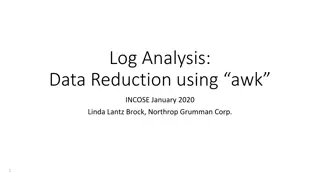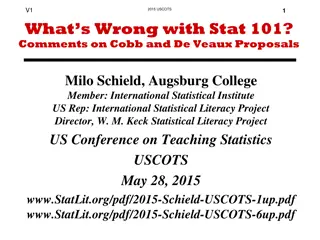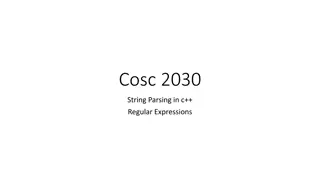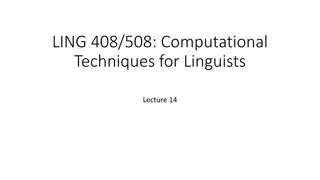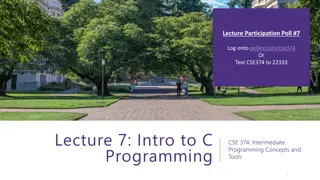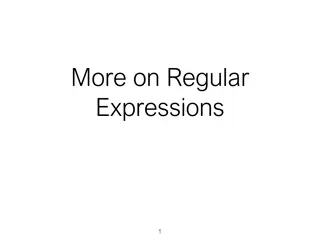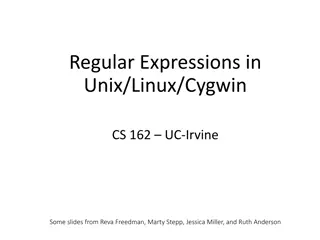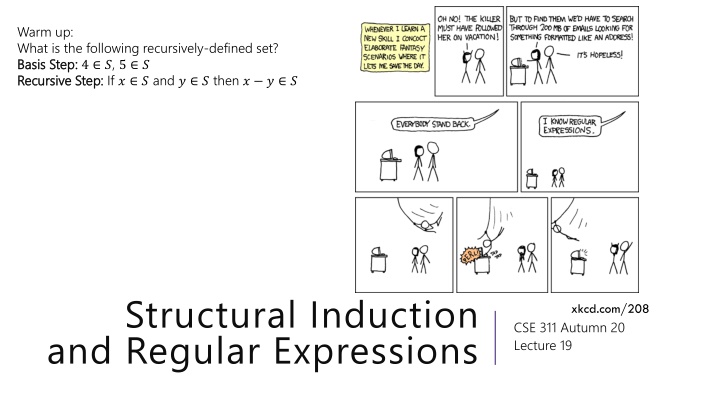
Recursively Defined Sets and Strings: Understanding Regular Expressions
Delve into the world of recursively defined sets and strings, the basis for regular expressions. Explore concepts like structural induction, basis steps, recursive steps, and functions on strings. Unravel the complexities of defining and manipulating strings with practical examples and recursive definitions. Discover the fundamental building blocks for searching patterns like email addresses using regular expressions.
Download Presentation

Please find below an Image/Link to download the presentation.
The content on the website is provided AS IS for your information and personal use only. It may not be sold, licensed, or shared on other websites without obtaining consent from the author. If you encounter any issues during the download, it is possible that the publisher has removed the file from their server.
You are allowed to download the files provided on this website for personal or commercial use, subject to the condition that they are used lawfully. All files are the property of their respective owners.
The content on the website is provided AS IS for your information and personal use only. It may not be sold, licensed, or shared on other websites without obtaining consent from the author.
E N D
Presentation Transcript
Warm up: What is the following recursively-defined set? Basis Step: Basis Step: 4 ?, 5 ? Recursive Step: Recursive Step: If ? ? and ? ? then ? ? ? Structural Induction and Regular Expressions xkcd.com/208 CSE 311 Autumn 20 Lecture 19
Announcements We have a few students still working on the midterm (due to special circumstances or personal emergencies) Please don t discuss the exam yet on Ed. We ll release solutions to the midterm later this week. I ll discuss more on Wednesday, once we have a slightly better sense of how long it took everyone from the responses to the last question. You re welcome to talk to each other about it, just make sure whoever you re talking to has finished. HW6 comes out tonight. It s due right before Thanksgiving. Designed to be done by Monday if you need to travel. Yes, I m aware of how unconvincing that statement may sound.
Strings Why these recursive definitions? They re the basis for regular expressions, which we ll introduce next week. Answer questions like how do you search for anything that looks like an email address First, we need to talk about strings. will be an alphabet alphabet the set of all the letters you can use in words. is the set of all words words all the strings you can build off of the letters.
Strings ?is the empty string The string with 0 characters in Java (not null!) : Basis: ? . Recursive: If ? and ? then ?? ?? means the string of ? with the character ? appended. You ll also see ? ? (a to mean concatenate i.e. + in Java)
Functions on Strings Since strings are defined recursively, most functions on strings are as well. Length: len(?)=0; len(??)=len(?)+1 for ? , ? Reversal: ??= ?; ???= ??? for ? , ? Concatenation ? ? = ? for all ? ; ? ?? = ? ? ? for ? ,? Number of ? s in a string #?? = 0 #??? = #?? + 1 for ? ; #??? = #?(?) for ? ,? {?}.
Claim len(xy)=len(x) + len(y) for all ?,? . Let ?(?)be len(x y)=len(x) + len(y) for all ? . Notice the strangeness of this ?()there is a for all ? inside the definition of ?(?). That means we ll have to introduce an arbitrary ? as part of the base case and the inductive step!
Claim len(xy)=len(x) + len(y) for all ?,? . Define Let ?(?)be len(x y)=len(x) + len(y) for all ? . We prove ?(?) for all ? by structural induction. Base Case: Inductive Hypothesis: Inductive Step: :Basis: ? . Recursive: If ? and ? then ??
Claim len(xy)=len(x) + len(y) for all ?,? . Define Let ?(?)be len(x y)=len(x) + len(y) for all ? . We prove ?(?) for all ? by structural induction. Base Case: Let ? be an arbitrary string, len(? ?)=len(x) =len(x)+0=len(x)+len(?). So we have ?(?). Inductive Hypothesis: Suppose ?(?) for an arbitrary ? . Inductive Step: :Basis: ? . Recursive: If ? and ? then ??
Claim len(xy)=len(x) + len(y) for all ?,? . Define Let ?(?)be len(x y)=len(x) + len(y) for all ? . We prove ?(?) for all ? by structural induction. Base Case: Let ? be an arbitrary string, len(? ?)=len(x) =len(x)+0=len(x)+len(?). So we have ?(?). Inductive Hypothesis: Suppose ?(?) for an arbitrary ? . Inductive Step: Let ? be an arbitrary character and let ? be an arbitrary string. len(xwa) =len(xw)+1 (by definition of len) =len(x) + len(w) + 1 (by IH) =len(x) + len(wa) (by definition of len) Therefore, len(xwa)=len(x) + len(wa). I.e., ?(??) holds. By the principle of induction, we have ?(?) for all ?. Therefore for all ?,? we have len(x y)=len(x)+len(y). :Basis: ? . Recursive: If ? and ? then ??
More Structural Sets Binary Trees are another common source of structural induction. Basis: A single node is a rooted binary tree. Recursive Step: If ?1 and ?2are rooted binary trees with roots ?1 and ?2, then a tree rooted at a new node, with children ?1,?2 is a binary tree. ?1 ?2
Functions on Binary Trees size( )=1 size( ) = size(?1) + size(?2) + 1 ?1 ?2 height( ) = 0 height( ) = 1+max(height(?1),height(?2)) ?1 ?2
Structural Induction on Binary Trees Let ? ?be size(?) 2 ??? ? ? +1 1 . We show ?(?) for all binary trees ? by structural induction. Base Case: Let ? = . size(?)=1 and height(?) = 0, so size(?)=1 2 1 = 20+1 1 = 2 ??? ? ? +1 1. Inductive Hypothesis: Suppose P(?) and P(?) for arbitrary binary trees ?,?. Inductive Step: Let ? = . ? ?
Structural Induction on Binary Trees (cont.) Let ? ?be size(?) 2 ??? ? ? +1 1 . We show ?(?) for all binary trees ? by structural induction. Inductive Step: Let ? = . ? ? height(?)=1 + max{ ??? ? ? , ??? ? ? } size(?)= 1 +size(?)+size(?) So ?(?) holds, and we have ?(?) for all binary trees ? by the principle of induction.
Structural Induction on Binary Trees (cont.) Let ? ?be size(?) 2 ??? ? ? +1 1 . We show ?(?) for all binary trees ? by structural induction. Inductive Step: Let ? = . ? ? height(?)=1 + max{ ??? ? ? , ??? ? ? } size(?)= 1 +size(?)+size(?) size(?)=1+size(?)+size ? 1 + 2 ??? ? ? +1 1 +2 ??? ? ? +1 1 (by IH) 2 ??? ? ? +1+2 ??? ? ? +1 1(cancel 1 s) 2 ??? ?(?)+ 2 ??? ?(?) 1 = 2 ??? ? ? +1 1 (? taller than subtrees) So ?(?) holds, and we have ?(?) for all binary trees ? by the principle of induction.
Course Outline Symbolic Logic (training wheels; lectures 1-8) Just make arguments in mechanical ways. Set Theory/Arithmetic (bike in your backyard; lectures 9-19) Models of computation (biking in your neighborhood; lectures 19-30) Still make and communicate rigorous arguments But now with objects you haven t used before. -A first taste of how we can argue rigorously about computers. This week: regular expressions and context free grammars understand these simpler computers After Thanksgiving: what these simple computers can do Last week of class: what simple computers (and normal ones) can t do.
Regular Expressions I have a giant text document. And I want to find all the email addresses inside. What does an email address look like? [some letters and numbers] @ [more letters] . [com, net, or edu] We want to ctrl-f for a pattern of strings pattern of strings rather than a single string
Languages A set of strings is called a language. language. is a language the set of all binary strings of even length is a language. the set of all palindromes is a language. the set of all English words is a language. the set of all strings matching a given pattern pattern is a language.
Regular Expressions Every pattern automatically gives you a language . The set of all strings that match that pattern. We ll formalize patterns via regular expressions ? is a regular expression. The empty string itself matches the pattern (and nothing else does). is a regular expression. No strings match this pattern. ? is a regular expression, for any ? (i.e. any character). The character itself matching this pattern.
Regular Expressions Basis: ? is a regular expression. The empty string itself matches the pattern (and nothing else does). is a regular expression. No strings match this pattern. ? is a regular expression, for any ? (i.e. any character). The character itself matching this mattern. Recursive If ?,? are regular expressions then (? ?) is a regular expression matched by any string that matches ? or that matches ? [or both]). If ?,? are regular expressions then ?? is a regular expression. matched by any string ? such that ? = ??, ? matches ? and ? matches ?. If ? is a regular expression, then ? is a regular expression. matched by any string that can be divided into 0 or more strings that match ?.
Regular Expressions (? ??) 0 0 1 1 0 0 1
Regular Expressions (? ??) Corresponds to {?,??} 0 0 1 1 Corresponds to {001,011} all length three strings that start with a 0 and end in a 1. 0 Corresponds to {?,0,00,000,0000, } 0 1 Corresponds to the set of all binary strings.
More Examples 0 1 0 1 0 1 00 11 0 1 00 11
More Examples 0 1 All binary strings 0 1 All binary strings with any 0 s coming before any 1 s 0 1 00 11 0 1 This is all binary strings again. Not a good representation, but valid. 00 11 All binary strings where 0s and 1s come in pairs
Practical Advice Check ? and 1character strings to make sure they re excluded or included (easy to miss those edge cases). If you can break into pieces, that usually helps. nots are hard (there s no not in standard regular expressions But you can negate things, usually by negating at a low-level. E.g. to have binary strings without 00, your building blocks are 1 s and 0 s followed by a 1 01 1 (0 ?) then make adjustments for edge cases (like ending in 0) Remember allows for 0copies! To say at least one copy use ?? .
Regular Expressions In practice EXTREMELY useful. Used to define valid tokens (like legal variable names or all known keywords when writing compilers/languages) Used in grep to actually search through documents. Pattern p = Pattern.compile("a*b"); Matcher m = p.matcher("aaaaab"); boolean b = m.matches(); ^ start of string $ end of string [01] a 0 or a 1 [0-9] any single digit \. period \, comma \- minus . any single character ab a followed by b (AB) (A B) (a|b) a or b a? zero or one of a (A ) a* zero or more of a A* a+ one or more of a AA* e.g. ^[\-+]?[0-9]*(\.|\,)?[0-9]+$ General form of decimal number e.g. 9.12 or -9,8 (Europe)
Regular Expressions In Practice When you only have ASCII characters (say in a programming language) | usually takes the place of ? (and perhaps creative rewriting) take the place of ?. E.g. 0 ? 1 10 is 0?(1|10)*
A Final Vocabulary Note Not everything can be represented as a regular expression. E.g. the set of all palindromes is not the language of any regular expression. Some programming languages define features in their regexes that can t be represented by our definition of regular expressions. Things like match this pattern, then have exactly that substring So before you say ah, you can t do that with regular expressions, I learned it in 311! you should make sure you know whether your language is calling a more powerful object regular expressions . But the more fancy features beyond regular expressions you use, the slower the checking algorithms run, (and the harder it is to force the expressions to fit into the framework) so this is still very useful theory. substring appear later.


